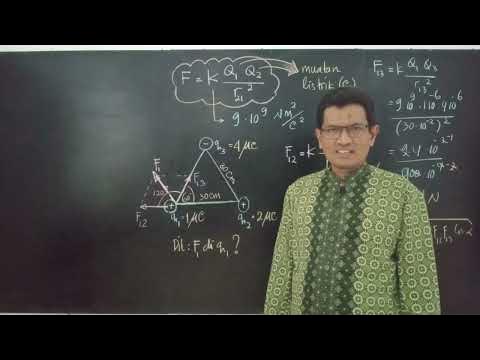2 Listrik Statis gaya listrik
Summary
TLDRThis video explains the concept of electric force and Coulomb’s law. It demonstrates how like charges repel and unlike charges attract, with the force being calculated using Coulomb’s law. The video further breaks down how the force depends on the size of the charges and the distance between them, highlighting the inverse square relationship with distance. A sample problem is solved, showing the process of calculating the force between two charges, providing a practical example of how the law works in real-life scenarios. This video serves as a clear introduction to understanding electric forces.
Takeaways
- 😀 Electric force occurs between charges: like charges repel, and opposite charges attract.
- 😀 The magnitude of the electric force depends on the size of the charges and the distance between them.
- 😀 Coulomb's Law defines the relationship between force, charge, and distance: F = k * (Q1 * Q2) / R².
- 😀 The force between two charges increases with the magnitude of the charges.
- 😀 The electric force decreases as the distance between the charges increases.
- 😀 The force is inversely proportional to the square of the distance between charges (R²).
- 😀 Coulomb's constant (k) has a value of 9 × 10⁹ N·m²/C² and is used in the Coulomb's Law formula.
- 😀 The unit of charge is Coulombs (C), and the unit of force is Newtons (N).
- 😀 In the example, two charges, Q1 and Q2, separated by 3 cm, experience a repulsive force of 100 N.
- 😀 When solving problems using Coulomb's Law, always convert units (e.g., from microunits to Coulombs, and from centimeters to meters).
Q & A
What happens when two charges of the same type are brought close to each other?
-When two charges of the same type, either both positive or both negative, are brought close to each other, they will repel each other. This is due to the electrostatic force of repulsion between like charges.
What happens when a positive charge and a negative charge are brought close to each other?
-When a positive charge and a negative charge are brought close to each other, they will attract each other. This is due to the electrostatic force of attraction between opposite charges.
What is Coulomb's Law and how is it expressed mathematically?
-Coulomb's Law describes the force between two charges. The formula is F = k * (qa * qb) / r^2, where F is the force between the charges, qa and qb are the magnitudes of the two charges, r is the distance between them, and k is Coulomb's constant (9 * 10^9 N·m^2/C^2).
How does the size of the charges affect the force between them?
-The force between two charges is directly proportional to the product of their magnitudes. This means that as the charges increase in size, the force between them also increases.
What is the relationship between the distance between two charges and the force between them?
-The force between two charges is inversely proportional to the square of the distance between them. This means that as the distance increases, the force decreases. Specifically, if the distance is doubled, the force becomes one-fourth of the original value.
How is the electric force affected if the distance between two charges is tripled?
-If the distance between two charges is tripled, the electric force becomes one-ninth of its original value. This is due to the inverse square law, where the force is inversely proportional to the square of the distance (3^2 = 9).
What does Coulomb's constant (k) represent in Coulomb's Law?
-Coulomb's constant (k) is a proportionality constant in Coulomb's Law, with a value of 9 * 10^9 N·m^2/C^2. It allows the formula to calculate the electric force between charges in SI units.
What are the units for charge (Q) and distance (r) in Coulomb's Law?
-The unit for charge (Q) is the Coulomb (C), and the unit for distance (r) is the meter (m) in Coulomb's Law.
How do you convert microcoulombs (µC) to coulombs (C)?
-To convert microcoulombs (µC) to coulombs (C), multiply by 10^-6. For example, 2 µC = 2 * 10^-6 C.
In the example calculation provided, what is the force between two charges of 2 µC and 5 µC separated by a distance of 3 cm?
-Using Coulomb's Law, the force is calculated as F = (9 * 10^9) * (2 * 10^-6) * (5 * 10^-6) / (3 * 10^-2)^2. The result is a force of 100 N.
Outlines

This section is available to paid users only. Please upgrade to access this part.
Upgrade NowMindmap

This section is available to paid users only. Please upgrade to access this part.
Upgrade NowKeywords

This section is available to paid users only. Please upgrade to access this part.
Upgrade NowHighlights

This section is available to paid users only. Please upgrade to access this part.
Upgrade NowTranscripts

This section is available to paid users only. Please upgrade to access this part.
Upgrade NowBrowse More Related Video

FISIKA KELAS XII || GAYA COULOMB - LISTRIK STATIS (PART 1)

Campo elétrico: Tudo que você precisa saber sobre um dos campos mais importantes da Física

[NEW VERSION!]GAYA COULOMB | Listrik Statis - Fisika Kelas 12

BAB 4 LISTRIK, MAGNET DAN SUMBER ENERGI ALTERNATIF - PART 1 (IPA Kelas 9 Kurikulum Merdeka)

Electric Charges & Fields in 10 mins 😱🔥 Ch 1 Physics Class 12 Boards 2024 Score 95+ Zaki Bhaiya

Listrik Statis ( Muatan Listrik - Hukum Coulomb - Medan Listrik - Beda Potensial & Energi Listrik )
5.0 / 5 (0 votes)